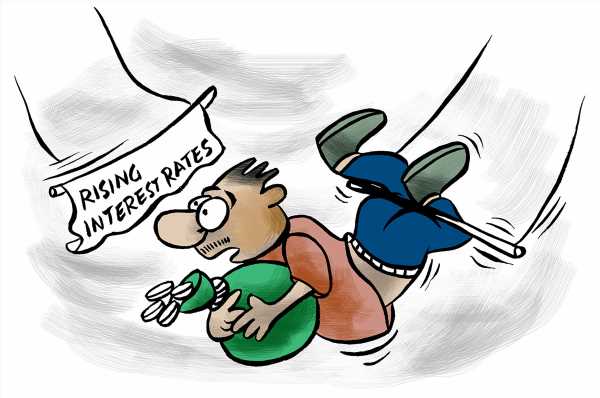‘RBI should pause rate hikes’
‘It will send a very strong signal that it is now our time to grow.’
Days after Prime Minister Narendra Modi exhorted the private sector to increase capital expenditure, Confederation of Indian Industries President Sanjiv Bajaj said private sector capital expenditure depends on consistent demand and needs a minimum return on investment.
In an interview with Arup Roychoudhury/Business Standard, Bajaj said there was a need for a production-linked incentive-like scheme in sectors like tourism, logistics, animation, etc, to create more jobs.
What is your outlook for the economy and the corporate sector for financial year 2023-2024?
Our economy has shown that it’s capable of resilient growth.
In a situation of global uncertainty, we are expected to grow at 7 per cent this year and probably 6.5 per cent next year.
We are seeing a significant interaction from the government with continued increase in public sector capex.
This not only helps to keep the economy growing by creating new jobs and new infrastructure, it also creates new demand.
And that should help with private sector capex as well.
This will provide the tailwinds for better growth in the coming years.
But we are also living in a very uncertain world. But within India, we see that inflation clearly has moderated.
We are seeing multiple sectors in the private industry that have now reached capacity utilisation levels where they are ready to invest.
After the concerted action that we saw on interest rates across the world through the pandemic, we believe it is time now to decouple from that.
Inflation is coming under control.
So, we hope the RBI will opt for a pause on rate hikes so that it sends a very strong signal that it is now our time to grow.
What kind of capex trends do you see from the private sector in FY24?
There are sectors where we have already started to see new investment.
What is encouraging is that in the third quarter, our capex utilisation was already at 74 per cent, which means many of those sectors are beyond that.
The PLI scheme is providing a shot in the arm for sectors like electronics.
We can see healthy investment in construction, chemicals and pharma.
The prime minister recently urged India Inc to step up investments. There is a feeling in the government that the private sector could do more in terms of capex. What would you say to that?
Very clearly the government has played a fabulous role in public sector investment.
As far as the private sector is concerned, most of the investment in the last two decades has come from this sector.
But the colour of money in the private sector is slightly different from the public sector.
The private sector needs to show a certain minimum return on the capital it borrows.
To that extent, private sector investment is driven by demand and consistent demand is one of the prerequisites.
I believe that we are very close to that situation, where we see a consistent demand curve likely to come up in the coming quarters.
Banks are also now in a situation where they have the ability and the readiness to lend.
So all we need to see are the right triggers for demand growth.
And interest rate is one of the biggest triggers.
But we must also keep in mind that we are living in a volatile, uncertain world and investments are not made for a day, a quarter, or a year.
Do you think there will be any impact of the collapse of Silicon Valley Bank, the largest bank failure since Lehman Brothers, on the Indian economy and financial sector?
There are three points to make here. One is the immediate, decisive steps taken by the US government with the treasury secretary announcing that depositors will be protected and the taxpayer would not be burdened.
I must say, the speed of action that we see in such issues in the US is something for us to learn from.
The medium-term issue is that one bank ended up providing 40 per cent of the requirements of the start-up world in the West.
Clearly, this shows the need to diversify and create more such entities so that there is no over-dependence on any one entity, however good it may have been.
The third lesson from this for countries like India is to learn from the triggers for the failures of Signature Bank or SVB.
Eventually, banking is about being prudent, being conservative, long term.
PLI has been seen as a success. Which other sectors can we have similar schemes for?
The PLI scheme is providing a long-term shot in the arm for a number of sectors where India has competitive strength, capability and capacity.
We’ve been recommending to the government that one of our main priorities in the short to medium term should be to create new jobs.
Like PLI focuses on new capital investment, we think that human investment, employment-based schemes, which we are calling ELI (employment-linked incentive schemes), where large sectors be it tourism, logistics, animation, gaming or filmmaking can also be brought in.
As the president of B-20 (the business track of G20), what are CII’s aims?
The last three years have shown the significant interconnectedness of global economies.
At the same time, we should all be acutely aware that we are still in a world that is going through a period of uncertainty.
And, hence, it requires a continuous dialogue.
We hopefully have the pandemic behind us, we still have a state of turmoil in Europe, we are starting to see positive signs for growth in markets like India.
For all this, leaders, thinkers, and the business community must come together to discuss, debate, and decide on action.
It may be coordinated action or complementary action.
And we believe that the Partnership Summit is a great opportunity to be able to do that.
And in a year where India has taken over the G20 presidency, getting these world leaders over here with policymakers, the business community is an ideal opportunity for us to chart out the future together.
Source: Read Full Article


